Cerebras Systems, a rising star in the field of artificial intelligence (AI) hardware, has unveiled a new AI inference tool designed to challenge Nvidia’s dominance in the AI market. The tool, which leverages Cerebras’ innovative hardware architecture, promises to deliver significantly higher performance and efficiency for AI inference tasks, potentially redefining the competitive landscape in AI computing.
Cerebras’ Bold Move Against Nvidia
Nvidia has long been the market leader in AI hardware, particularly with its powerful graphics processing units (GPUs) that are widely used for both AI training and inference. However, Cerebras is now positioning itself as a formidable competitor with its new AI inference tool, which utilizes the company’s unique Wafer-Scale Engine (WSE) technology.
The WSE, a massive silicon chip much larger than any traditional GPU, is specifically designed to handle the heavy computational loads required for AI workloads. Cerebras claims that its new tool, optimized for this architecture, can outperform Nvidia’s GPUs in terms of speed and energy efficiency, especially in large-scale inference tasks where real-time decision-making is crucial.
How Cerebras’ Inference Tool Works
Cerebras’ new inference tool focuses on accelerating the process of AI inference—the stage where trained AI models make predictions or decisions based on new data. The tool uses Cerebras’ WSE technology to process these tasks more rapidly and efficiently than conventional GPUs.
The key advantage lies in the WSE’s ability to handle massive amounts of parallel processing in a compact space, reducing data transfer delays and optimizing memory usage. This results in faster inference times and lower power consumption, which is critical for applications such as autonomous vehicles, real-time analytics, and edge AI deployments.
“By optimizing for inference performance, we’ve created a tool that can deliver unparalleled speed and efficiency,” said Andrew Feldman, CEO of Cerebras Systems. “Our technology is uniquely suited to meet the growing demand for high-performance AI computing, and we believe it has the potential to redefine the market.”
Performance Claims and Industry Impact
According to early benchmarks released by Cerebras, the new inference tool delivers up to twice the performance of Nvidia’s A100 GPU when running large AI models in inference mode. Additionally, the tool reportedly consumes less power, which could result in significant cost savings for organizations running AI at scale.
The promise of higher performance and energy efficiency positions Cerebras as a strong contender in the AI hardware market, particularly for companies looking to scale their AI operations without incurring high infrastructure costs. This development comes at a time when demand for AI inference capabilities is rapidly increasing across industries, from healthcare and finance to retail and automotive.
Challenges Ahead for Nvidia
While Nvidia remains the undisputed leader in AI hardware, the emergence of competitors like Cerebras underscores the growing demand for specialized AI solutions that go beyond the capabilities of traditional GPUs. With the rise of new players, Nvidia faces increased pressure to innovate and enhance its own offerings to maintain its market share.
However, Nvidia still holds significant advantages, including a large ecosystem of developers and software tools that are optimized for its GPUs. The company has also been investing heavily in its AI capabilities, including the development of new AI chips and software platforms to support a wide range of applications.
The Future of AI Hardware Competition
As AI technology continues to evolve, the competition between Cerebras and Nvidia highlights a broader trend in the industry: the shift toward specialized hardware that is tailored to specific AI workloads. This competition could drive further innovation in the field, leading to more efficient and powerful AI tools that benefit consumers and businesses alike.
For now, Cerebras’ new inference tool represents a bold challenge to Nvidia’s dominance. If the performance claims hold true, it could mark a significant shift in the AI hardware market, opening up new possibilities for AI development and deployment.
As both companies continue to innovate, the race for AI supremacy promises to be a dynamic and closely watched battle in the tech world.





